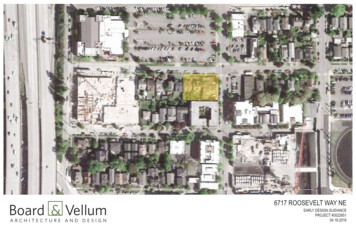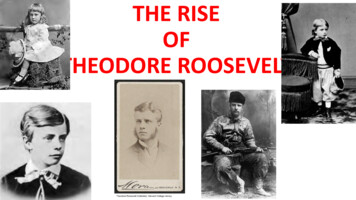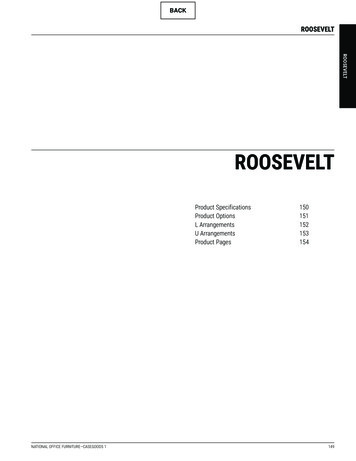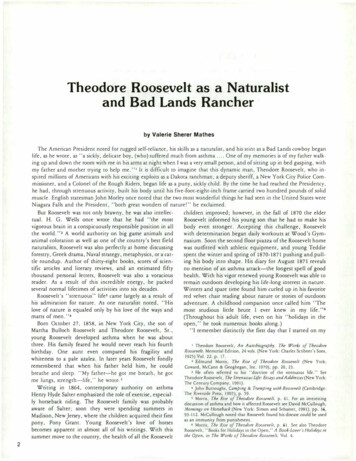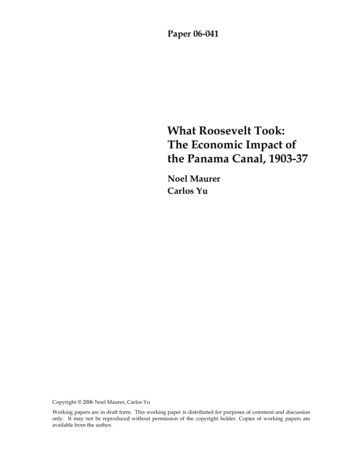
Transcription
Paper 06-041What Roosevelt Took:The Economic Impact ofthe Panama Canal, 1903-37Noel MaurerCarlos YuCopyright 2006 Noel Maurer, Carlos YuWorking papers are in draft form. This working paper is distributed for purposes of comment and discussiononly. It may not be reproduced without permission of the copyright holder. Copies of working papers areavailable from the author.
What Roosevelt TookNoel MaurerCarlos YuWhat Roosevelt Took:The Economic Impact of the Panama Canal, 1903-37AbstractThe Panama Canal was one of the largest public investments of its time. In the first decade of its operation, the Canal produced significant social returns for the United States. Most of these returnswere due to the transportation of petroleum from California to the East Coast. Few of these returns,however, accrued to the Panamanian population or government. U.S. policy operated to minimizethe effects of the Canal on the Panamanian economy. The major exception to this policy was theAmerican anti-malarial campaign, which improved health conditions in the port cities.“I took the Isthmus.” –President Theodore Roosevelt, 1904.“Why, it’s ours, we stole it fair and square.” –Senator Samuel Hayakawa, 1977.Modern economic historians have been skeptical of the Canal’s economic benefitsto the United States. Stanley Lebergott, for example, noted that the Canal “gaveequal advantage to any nation that chose to use the Canal,” and the benefits forcoast-to-coast shipping accrued “in the same proportion as American railroads wereinjured.”1 Early boosters of the Panama Canal, however, had no such doubts. Forexample, a 1903 estimate delivered to Congress concluded that a canal would produce benefits which when capitalized would be worth 1.2 billion, or 4.7 percent ofU.S. GDP.2On the other hand, most observers concur that the Canal strongly stimulatedPanamanian economic growth between 1915 and 1930.3 Contemporaries certainlyexpected the Canal to benefit the Panamanian economy. The Panamanian ambassador to Washington waxed enthusiastic in 1913, as he traveled the U.S. trying todrum up investment: “Our country has the Canal within its own territory, andtherefore enjoys the greatest advantage The market for the products consumed byships passing from one ocean to the other, or arriving at the Canal’s terminal ports,1 Lebergott, “The Returns,” p. 240.2 58th Congress, Second Session, S.D. 51.3 See Federal Research Division, A Country Study, Chapter 3, Leonard, “The Commissary Issue,” Langley, “Negotiating NewTreaties,” particularly p. 2.1
What Roosevelt Tookis a market that naturally belongs to Panama, and no other country can handle ourcompetition.”4 In 1917, the authors of the Blue Book of Panama asserted that, “TheRepublic of Panama should shortly become one of the business centers of the universe.” Its authors went on to assert that “the administration and upkeep [of thePanama Canal] have brought large sums of money into the country.”5We argue that the boosters of an Isthmian Canal had it right: the Panama Canalproduced substantial benefits for the consumers of transportation during its firstquarter-century of operation. Our minimum estimate of the social rate of return iswell in excess of the returns from U.S. government bonds. We also argue that thelion’s share of the social returns from the Canal accrued to the United States. In fact,the lion’s share of the benefits originated from the transportation of petroleumproducts from California to the East Coast.We also argue, however, that those who predicted that the Canal would bringgreat economic benefits to Panama had it wrong. The Canal’s direct benefits to Panama were relatively small. The United States used its military leverage to forcenewly-independent Panama into accepting a payment for the use of its territory thatwas far smaller than the previous agreement which had been freely negotiated between Colombia and the French-owned Panama Canal Company. In fact, it wassmaller than the American offer Colombia had previously rejected.American policy then acted to deliberately minimize the spillovers from the Canal.The Canal Zone deliberately avoided employing Panamanian labor. The U.S. alsoexplicitly prohibited Panamanian businesses from providing services to the CanalZone or ships transiting through the Zone. The Canal Zone administration did construct sanitary works in both Colón and Panama City, but it charged the Panamanian government the full cost of construction and operation, including interest.Lastly, despite the fact that the United States explicitly exercised a protectorate overPanama, including a fiscal agent in Panama City, the American imprimatur did nottranslate into lowered borrowing costs for the Republic of Panama.The major exception to the lack of spillovers from the Panama Canal was thegreat American anti-malarial campaign in 1906-09. These efforts greatly reduceddeaths from malaria and yellow fever in Panama City and Colón, at no expense tothe Republic of Panama. Few contemporaries, however, ever mentioned the greatreduction in the prevalence of disease as a benefit of the Panama Canal. Ironically,the great benefits for Panama that contemporaries expected did not materialize,while the greatest benefit proved to be the precocious and unexpected arrival of newpublic health technology on the Isthmus.4 Eusebio Morales, Ensayos, p.119.5 William Scoullar, The Blue Book of Panama, preface and p. 62.2
What Roosevelt TookThe Panama Canal And World CommerceThe direct commercial benefits produced by the Panama Canal depend uponthree variables. The first is the cost of constructing and operating the Panama Canal.The second is the reduction in the cost of transportation induced by the opening ofthe Canal. The third is the sensitivity of shippers to the cost of transportation. Wetake each of these three factors in turn.The Costs of the Panama CanalThe Panama Canal was the most expensive public works project in American history until that time. Between 1903 and 1914, the United States spent 302 million onconstruction. In 2004 dollars, adjusted with the U.S. GDP deflator, the Panama Canal cost 4.4 billion.The Canal exceeded its estimated construction cost by a considerable margin. A1902 congressional committee authorized the purchase of the New Company’s assets based on a projection of construction costs of 144 million. The committee approved a bond issue of 130 million in order to finance construction.6 As early as1905, however, the New York Times complained that the Isthmian Canal Commissionwould have spent 66 million by the end of the year, with “no dirt flying.” TheTimes blamed the part of cost overruns on inflated salaries for Canal personnel.7 Bythe time initial construction finished in 1914—work would continue for four moreyears as a result of unexpected landslides—the direct construction costs surpassedinitial estimates by a factor of 2.1. The scale of Panama Canal cost overruns, therefore, was significantly higher than on comparable projects like the Erie Canal (1.5),Hoover Dam (1.1), or the Bay Area Rapid Transport system (1.6), although PanamaCanal cost overruns did compare favorably to the Big Dig (5.2 and counting).8Direct construction costs, however, were not the only costs of the canal. The U.S.also spent 40 million to purchase the assets of the New Panama Canal Companyand 10 million for the Panamanian government. In addition, the U.S. incurred animplicit interest cost over the construction decade. Lastly, the U.S. needed to defendthe Canal, which necessitated the construction of barracks, shore defense batteries,and naval support facilities.We calculated implicit interest costs using the yield on long-term U.S. federalbonds. For each year between 1903 and 1914, we calculated the cumulative amountspent on construction. We then multiplied that amount by the interest rate in order6 New York Times, 20 January 1902.7 “Hot Time in Prospect for Canal Commission,” New York Times, 22 November 1905.8 Data on cost overruns on the Erie Canal, Hoover Dam, and Big Dig from Engerman and Sokoloff, “Digging the Dirt,” p. 38.BART overruns from http://www.sfcityscape.com/transit/BART.html. The recent BART airport extension exceeded its initial cost projection by a factor of 1.5, slightly less than the overruns on the rest of the BART project.3
What Roosevelt Tookto determine the financing cost. Lastly, we converted the total cost, into 1925 dollarsusing the U.S. GDP deflator. The total cost of the Canal construction, including interest, came to 763.7 million in 1925 dollars.The initial Canal proposal envisioned no special expenditures for Canal defense.The Isthmian Canal Commission believed that the Canal was essentially indefensible, since “a small party of resolute men, armed with a few sticks of dynamite, couldtemporarily disable it without great difficulty.” In addition, if an enemy fleet dominated the Caribbean, then the Canal would be essentially worthless to the UnitedStates. Rather than liberate the U.S. from the need to build a two-ocean Navy, Canaldefense would require even more ships, for doubtful security gains.9The Taft Administration, however, rejected neutralization and established the Panama Fortification Board in 1909. A landslide in 1916, meanwhile, prompted Congress to decide to build the two-ocean fleet which the Canal was intended to obviate.10 Military needs expanded to include a large permanent garrison, coastal defense batteries, and, eventually, air defense. We obtained the cost of defense-relatedconstruction from various copies of the Annual Report of the Governor of the PanamaCanal. Using the same procedure outlined above, we calculated the total cost of defense-related construction to be 157.9 million in 1925 dollars, including implicit interest expenses.The total cost of the Panama Canal, therefore, came to 921.7 million in 1925 dollars. 921.7 million in 1925 dollars is the equivalent of 8.3 billion in 2004 dollars,but a better sense of the project’s scale is to ask how much the Panama Canal wouldcost today as a constant share of U.S. GDP. The answer to that question is 119.4 billion.Transportation Cost Savings of the Panama CanalThe Panama Canal’s chief benefit to world trade came from shortening distance.Without it, trade between the east and west coasts of North America, or between thewest coast of North America and Europe, had to either travel along the transcontinental railroad, around the southern tip of South America, or via the Tehuantepec orPanama railroads. Sending cargoes by the Isthmian railroads could cut distance, butat an additional cost of 3.00 per ton at Panama and 3.50 per ton at Tehuantepec.11The Canal had little impact on shipping distances between Europe and Asia orEurope and the Antipodes, which could travel alternate routes.9 Hains, “An Isthmian Canal,” p. 4, and the Report of the Isthmian Canal Commission, 1899-1901, p. 253.10 Braisted, The United States Navy, pp. 186-90.11 Huebner, “Economic Aspects,” p. 819. The additional cost of 3.00 3.50 per ton would obviate most of the cost savingsfrom the shorter route.4
What Roosevelt TookTABLE 1 AROUND HEREHow large were the transportation costs savings engendered by the Panama Canal? Saif Mohammed and Jeffrey Williamson have compiled a series of shippingcosts between Portland, Oregon, and the United Kingdom. Their data on shippingcosts are reproduced in Table 2. In 1922, the first year in which the Panama Canalwas fully open to civilian traffic, shipping costs dropped 31 percent. Since the Canalreduced the distance between Portland and Liverpool by 42 percent, it seems likelythat the Canal’s opening caused most of the fall in freight rates.TABLE 2 AROUND HEREPart of the cost of transporting a ton of cargo, however, does not change with distance: loading and unloading, warehousing, insurance, docking fees, etcetera. Weestimated the fixed cost of shipping by solving the following pair of simultaneousequations with two unknowns:(fixed cost) (distance before canal) (per-mile cost) (total cost per ton before canal)(fixed cost) (distance after canal) (per-mile cost) (total cost per ton after canal)Subtracting the fixed cost of shipping from the total cost of shipping one ton fromthe West Coast to Europe produced an estimate of the fixed cost per ton of 3.12 in1925 dollars.12 The variable cost of transporting a ton of cargo one mile, therefore,was approximately 0.07 (U.S.) in 1921-22.TABLES 3 AND 4 AROUND HEREWe then estimated shipping costs per ton-mile for the rest of the 1920s by subtracting our estimate of fixed costs from the total cost per ton-mile. Since the U.S.required that all transcontinental shipping be carried by U.S.-flagged vessels, it costsignificantly more per-mile than international shipping. We therefore calculatedper-mile costs separately for transcontinental and international routes.We calculated the transportation cost savings generated by the opening of theCanal under three assumptions. First, we assumed that the opening of the PanamaCanal had no effect on the fixed cost of shipping. Inasmuch as the Canal reducedinsurance costs, our estimates bias downwards the cost savings it generated, although contemporary observers claimed when writing about the choice of shipsabout whether to use the Panama Canal or travel around Cape Horn, “Insurancerates are not likely to be different on the various alternative routes.”1312 Canal tolls increased the fixed cost of shipping. We account for this by substracting the Canal’s cost of operations from ouroverall social savings estimates.13 Hutchinson, “Voyage Costs,” p. 577.5
What Roosevelt TookSecond, we assumed that all of the reduction in per-mile shipping costs in the late1920s came from improvements in shipping technology or drops in the cost of inputs such as fuel and labor. We do not attribute them to the opening of the Canal.This assumption biases downwards our estimates of the Panama Canal’s transportation cost savings.Third, we assumed that the same amount of cargo would be shipped between thesame ports in the absence of the Panama Canal. Following Rockwell, we assumedthat intercoastal cargoes would be shipped via the transcontinental railroad. Sincewe do not have data on the value of the cargoes transiting the Canal, we do not takeinto account savings in inventory costs due to lowered time in transit. Table 5 presents the basic estimates of the cost savings produced by the Panama Canal, brokendown by route and year.TABLE 5 AROUND HEREPrice SensitivityWe believe estimates of cost savings in Table 5 are close to an upper-bound on thePanama Canal’s benefits to world commerce, even though they do not include savings in insurance and inventory cost. We believe the estimates are close to an upperbound because it is not at all clear that, were the Canal closed and transportationcosts commensurately higher, the cargoes originally shipped through the Canalwould even have been shipped.For example, the lion’s share of the cargo passing through the Canal by the late1920s consisted of petroleum from southern California and lumber from the PacificNorthwest. However, both products had relatively accessible substitutes that didnot pass through the canal: Venezuelan oil and Southern pine lumber. Much thesame can be said of many of the international cargoes, like Philippine cane sugar orcopra, both of which faced competition from alternate sources and domestic substitutes. Thus, inasmuch as consumers are sensitive to price, therefore, then the benefits from the Canal will be lower than our basic cost-savings estimates.We therefore adjusted our calculations for various estimates of the price elasticityof demand for sea transportation. Doing so allows us to account for the availabilityof substitutes to ocean transport, should its price rise due to the lack of the PanamaCanal. We calculated the ratio between the social savings at a given price elasticityand the social savings when the price elasticity is different from zero using the following two equations, where φ is the ratio between the cost of ocean transportwithout the use of the Panama Canal and the cost of ocean transport using the Panama Canal and ε is equal to the price elasticity of demand. Since the proportionalcost savings of the canal were different for every route, we calculated the change in6
What Roosevelt Tookthe cost savings for various demand elasticities separately for every route and thenaggregated upwards. The results are presented in Table 6.(1)Sεφ 1 ε 1for ε 1. S 0 (1 ε )(φ 1)(2)Sεln φ for ε 1.S0 φ 1Social Rate of Return on the Panama CanalDid the transportation cost savings produced by the Panama Canal justify thehigh construction cost? In order to answer this question, we divided the transportation cost savings estimated above by the canal’s construction cost in order to produce a “social rate of return.” The social rate of return, as we have defined it, measures the flow of benefits to the users of the Canal’s services. If those returns arelower than the opportunity cost of capital, then the Panama Canal did not add valueto the world economy.INSERT TABLE 6 AROUND HEREEven at the extreme assumption of a demand elasticity of 2.0, the average socialsavings generated by the Canal, as a percentage of the Canal’s total constructioncost, remains well in excess of the 4.2 percent real return on federal governmentbonds during the period. In short, inasmuch as the rate of return on U.S. government bonds proxies the opportunity cost of capital, then the Panama Canal generated significant savings for the world economy during the 1920s.An alternative way to compare the social returns generated by the Panama Canalwith the returns that could be generated by buying back government debt is to calculate the “internal rate of return,” or IRR, for the Panama Canal project. The IRR isthe discount rate at which the net present value of a series of cash flows is equal tozero. It can be used to compare the returns available from different projects withdifferent patterns of investment outlays and cash revenues.Table 6 calculates the inflation-adjusted IRR for the Panama Canal, counting social returns as a “cash flow.” It also calculates the IRR that would result from investing the same amount (over the same time period) in federal government bonds instead. Even at a demand elasticity for transportation of -2.0, the IRR for the PanamaCanal is more than 50 percent higher than the IRR for government bonds.7
What Roosevelt TookMen, Plans, Canals, PanamaThe German scientist-explorer Alexander von Humboldt first proposed an Isthmian canal in 1811. However, the disease environment and insufficient technicalability prevented any serious efforts towards the goal until the 1850s, when a groupof American investors constructed a railroad across Panama, then a province of Colombia. As a witness told a Senate committee in 1849, the railroad was meant topave the way for a canal “by showing to the world how immense this business is.”The railroad proved to be phenomenally profitable.14Nevertheless, no concrete efforts to construct a canal began until the engineerFerdinand de Lesseps, fresh from his triumph at Suez, turned his attention to Central America. In 1878, De Lesseps sent Lieutenant Lucien Wyse, on leave from theFrench Navy, to scout out potential canal routes in Panama and Nicaragua. Wysenegotiated an agreement to build a canal in Panama with the Colombian government. The Wyse Concession promised Colombia an annual payment of 250,000, inaddition to the 250,000 annuity already provided by the Panama Railroad Company. The Wyse Concession also promised the Colombians 5 percent of the canal’sgross revenues for the first 25 years, 6 percent for the subsequent quarter-century, 7percent for the third quarter-century, and 8 percent for the final 24 years of the concession. At the end of 99 years, the Canal was to revert to Colombian control. Wysethen traveled to New York, where he secured the agreement of the Panama RailroadCompany to sell its shares to De Lesseps’ company for twice their market value.15De Lesseps calculated that he would be able to build a sea-level canal across Panama for 240 million, including interest costs. He also forecasted maritime trafficof 60 million tons a year, which would generate 18 million in toll revenue and 8million in profit. De Lesseps used these estimates to raise 60 million in capital, ofwhich 6.4 million went to pay for underwriting fees, “remuneration to banks,” andpublicity. Another 17 million purchased the Panama Railroad, and the canal venture took over the Railroad’s 6 million in outstanding debt.16Such an inauspicious financial start boded ill for the entire project. The Frenchengineers proved unable to construct a sea-level canal across Panama. Mudslidesensured that the walls of the canal had to be dug at a 22.5 angle rather than theplanned 45 . That, of course, magnified the amount of earth that had to be moved.Unfortunately, the French method of simply dumping the spill in nearby valleys hadthe twin side effects of exacerbating mudslides during the rainy season—since thefill blocked natural watercourses—and creating malarial swamps that retarded the14 Between 1856 and 1870, the Panama Railroad’s net margin averaged 53%. Memoría de Hacienda, p. 9.15 McCullough, The Path, p. 66-67.16 McCullough, The Path, pp. 73, 83, 125, and 128-129.8
What Roosevelt TookFrench enterprise’s efforts to reduce mortality rates among its employees. In 1887the French gave up trying to build a sea-level canal, and redesigned their projectaround a series of locks designed by Alexandre Gustave Eiffel.17Unfortunately, the admission that a sea-level canal was impossible came too lateto save the French effort. The public failed to take up new bond issues in the required amounts. The French legislature subsequently refused to suspend the company’s debts, and in 1889 the company went bankrupt.18 The assets were reorganized under the name of the New Panama Canal Company. The New Company continued some spotty construction efforts and operated the Panama Railroad, but thecanal project remained essentially dead.American governments long desired the construction of a canal across the CentralAmerican isthmus because of the economic benefits it would bring. In 1878, thesame year Wyse gained his concession from the Colombian government, a prominent Wall Street analyst estimated that an Isthmian canal would save world shipping 48 million per year, of which 36 million would accrue to the United States.19Two years later, President Rutherford Hayes declared, “The policy of this country isa Canal under American control. Our commercial interest is greater than that of anyother country.”20 The failure of the French to successfully finish a canal in Panamadid little to change American opinions about the value of an Isthmian canal.The Spanish-American War in 1898 reignited American interest in an Isthmiancanal. In 1901 the U.S. signed the Hay-Pauncefote Treaty with Great Britain, whichremoved British opposition. The Isthmian Canal Commission then recommended aNicaraguan route. The reason was neither technical nor political—rather, the NewCompany demanded too much ( 109 million) for its properties.21Philippe Bunau-Varilla, an engineer under De Lesseps and the owner of a substantial interest the New Company, convinced the company’s management in Paristo reduce its price to 40 million. His chief argument was that the New Company’sconcession from the Colombian government was slated to expire in 1904, afterwhich its shareholders would receive nothing for their investments. Bunau-Varillathen informed Senator Mark Hanna (R-Ohio) of the lower offer. Senator Hanna, inreturn, blocked in committee a bill that would have approved construction along theNicaragua route. Two weeks later, on January 28, 1902, Senator John Spooner (RWisconsin) introduced a bill that authorized the President to purchase the assets of17 McCullough, The Path, pp. 93-94.18 McCullough, The Path, p. 203.19 McCullough, p. 39.20 Cited in Calvo Ospina, “Panama’s Home Waters.”21 Report of the Isthmian Canal Commission, 1899-1901, p. 175, and New York Exchange Telegraph, November 17, 1901. 109 millionin 1903 dollars is the equivalent of 1.9 billion in 2004 dollars, or 50.2 billion when adjusted for relative share of GDP.9
What Roosevelt Tookthe New Company for 40 million as long as a satisfactory agreement could be arranged with Colombia.22The Colombians realized that they were in a good position. The French concession expired in 1904, when it would revert to Colombia. If Colombia could simplydelay an agreement with the United States until then, the Colombian governmentwould be able to receive some or all of the 40 million promised the New Companyfor its properties.Colombia ran two risks with this strategy. The first was that the United Statesmight decide to build a canal in Nicaragua in the meantime. The second was thatthe U.S. might choose to intervene militarily. The civil war of 1899-1902 was winding down, but the violence had not stopped, and the U.S. had in fact briefly occupied part of Panama in 1901.23As part of its proposal, the U.S. demanded the cession of a ten-mile wide bandaround the canal, including the cities of Colón and Panama City. Ambassador Carlos Martínez rejected the proposal, but wrote Bogotá insisting that Colombia wouldhave to accept a lease of “at least 200 years” for a six-mile wide zone. Martínez alsourged that Bogotá focus on retaining Panama City and Colón and getting a good financial deal, rather than symbolic negotiations over sovereignty and legal jurisdiction.24In February 1902, the Colombian government replaced Martínez with JoséVicente Concha. Concha arrived prepared to accede to most of the Americans’ demands, with two exceptions. First, Concha insisted that “neither national, local, departmental, nor any other sort of tax on the canal be prevented.” Second, Conchainsisted upon an up-front payment of 7 million and an annual rent of 600,000, although his instructions allowed him to defer rent negotiations until later, and hewas prepared to forego the initial payments in return for a share in the Canal equalto or higher than those provided by the Wyse Concession. Concha believed thatU.S. threats to build in Nicaragua were hollow.25 The Nicaraguan route would runalong the Costa Rican border, and the Costa Rican government showed little sign ofagreeing to an American presence.2622 Miner, The Fight, pp. 124-25.23 Grimmett, “Instances of Uses,” p. 12.24 Uribe Vargas, Los últimos derechos, chapter 10.25 Uribe Vargas, Los últimos derechos, chapter 11, and Libro Azul, pp. 116-117.26 Hill, “The Nicaraguan Canal,” pp. 203, 207-08. A protocol signed in 1887 granted both Nicaragua and Costa Rica a 6 percentinterest in any canal constructed along the San Juan River. An arbitration commission headed by President Grover Clevelandnegated Costa Rica’s right to a share of canal revenues, but agreed that Costa Rica had a veto over construction and the right todemand compensation. An 1899 contract granted Nicaragua an up-front payment of 500,000 and an 8 percent share in thecanal, but no agreement had been reached with Costa Rica as of 1903.10
What Roosevelt TookThe United States, however, showed little signs of compromising on either issue.On September 17, 1902, in response to unrest on the isthmus, the U.S. sent Marinesto guard all trains crossing Panama and stationed ships off both terminals. Underpressure to concede the Americans’ points, Concha stormed out of the negotiationsand returned to Colombia. “In no case,” wrote Concha, “for any human reason, willI sign any treaty with the government of the United States while its troops continueto occupy Colombian territory against every principle of justice and in violation of apublic promise.”27The Colombian chargé d’affaires, Tomás Herrán, was left in charge of the negotiations. Herrán was out of his league, under pressure both from Bogotá and theAmericans. On January 3rd, 1903, Herrán received a cable from his government insisting that he obtain a final offer from the U.S. Secretary of State, John Hay, as soonas possible. After receiving a subsequent message from Hay implying that his refusal would cause the Americans to build in Nicaragua instead, Herrán signed atreaty in Hay’s home in the presence of William Cromwell, a lawyer for the NewPanama Canal Company.28 Cromwell and Bunau-Varilla had, in fact, helped draftthe agreement.29The Hay-Herrán Treaty essentially granted all the Americans’ demands. The U.S.received a six-mile zone within which it could deploy troops with Colombia’s consent, construct a canal, and control public health. Colombia also renounced its rightsto a share of the revenues under the Wyse Convention and the 250,000 annuitypaid by the Panama Railroad, in return for 10 million and a new annual payment of 250,000 that would begin in 1912.The treaty’s terms did not go down well in Bogotá. The Colombian senate rejected it in a unanimous vote. President Roosevelt erupted at the news. “They aremad to get hold of the 40 million of the Frenchmen, and they want to make us aparty to the gouge.”30 He went on to call the Colombians “blackmailers,” “homicidal corruptionists,” and “cut-throats,” ending with, “You could no more make anagreement with the Colombian rulers than you could nail currant jelly to a wall.”31The Colombian vote convinced Roosevelt to intervene.32 In addition to the possible Costa Rican complications along the Nicaraguan route, Roosevelt doubted thetechnical feasibility of dredging the San Juan River. A law professor from ColumbiaUniversity, John Moore, provided a legal justification for the intervention by sug27 Uribe Vargas, Los últimos derechos, chapter 11.28 Domm, La crisis de Panamá, p. 47.29 Mabry, “Acquisition of the Panama Canal.”30 Major, Prize Pos
What Roosevelt Took 3 The Panama Canal And World Commerce The direct commercial benefits produced by the Panama Canal depend upon three variables. The first is the cost of constructing and operating the Panama Canal. The second is the reduction in the cost of transportation induced by the opening of the Canal.


